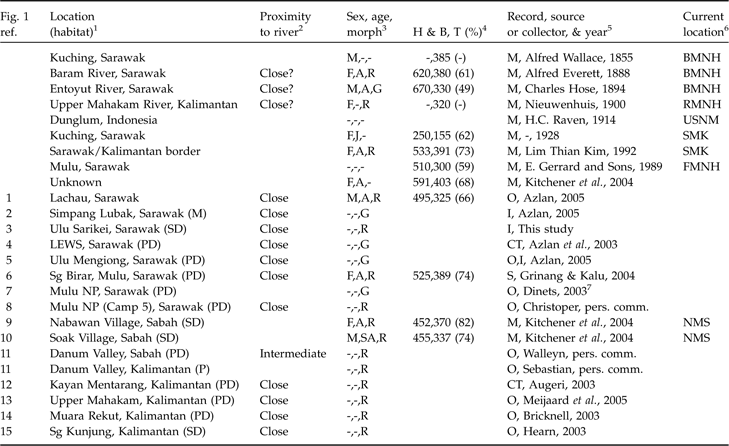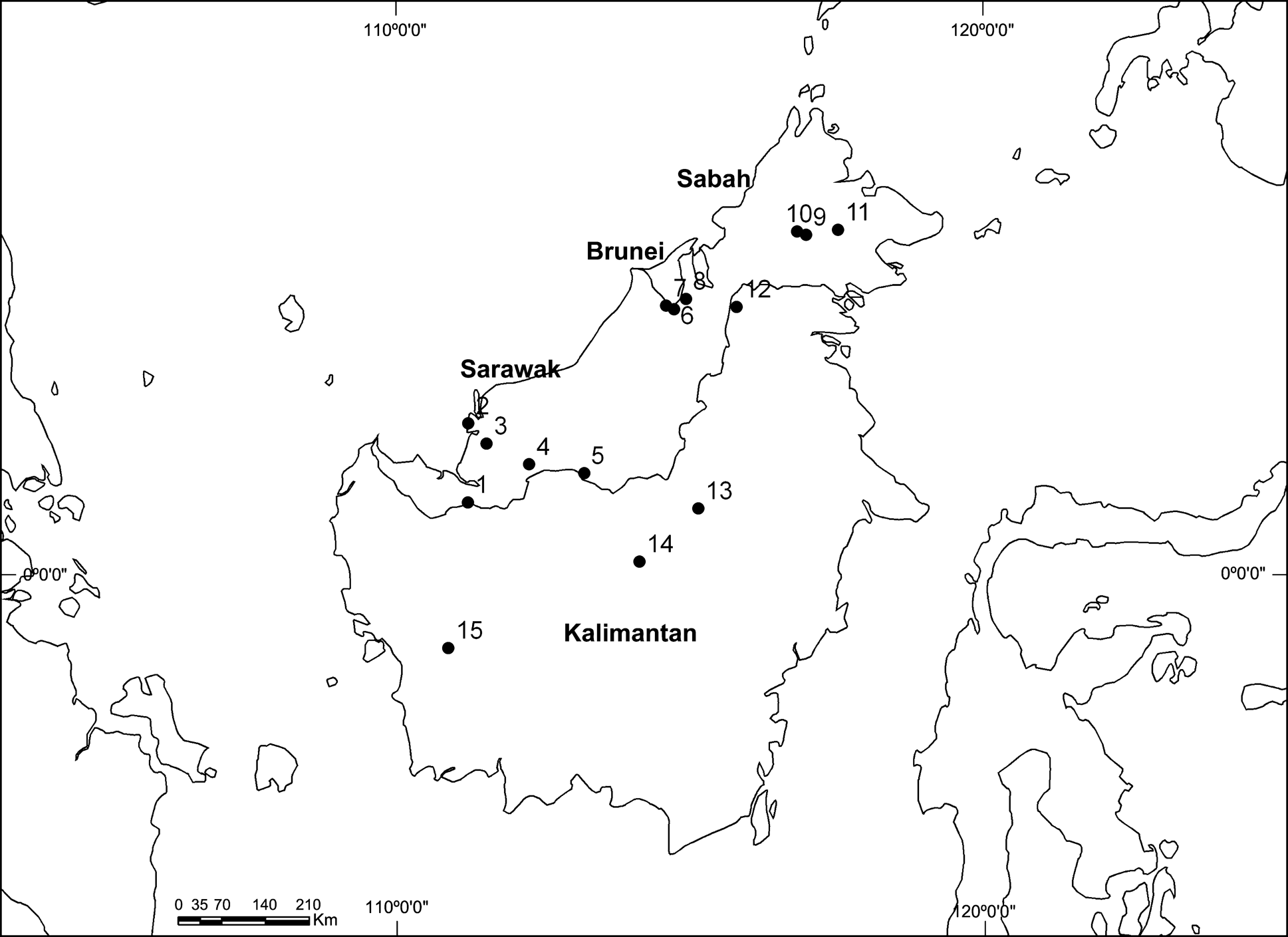The bay cat Catopuma badia, endemic to Borneo, is one of the rarest felids in the world (Meijaard, 1997; Sunquist & Sunquist, Reference Sunquist and Sunquist2002). However, small felids such as the bay cat receive little conservation attention in Borneo because these species are uncommon, rarely seen, and compete for conservation attention with more charismatic species. The bay cat is categorized as Endangered on the IUCN Red List (IUCN, 2006) and is listed in Appendix II of CITES (2007). Although the bay cat is legally protected in all three countries within its range (Brunei, Malaysia and Indonesia), all of which are signatories to CITES, enforcement is minimal. Since the bay cat’s discovery by Wallace in 1858 and naming by Gray (Reference Gray1874), knowledge of the species’ distribution has remained poorly known (Sunquist & Sunquist, Reference Sunquist and Sunquist2002). Our aim was to document the distribution of the bay cat and any threats to its persistence, and to recommend areas for further investigation of the species’ presence.
Between March 2003 and April 2006 we used camera traps, field observation, interviews with local villagers, hunters and researchers, reviewed literature and local museum records, and examined preserved specimens. Camera trapping was carried out in Sarawak, at Lanjak-Entimau Wildlife Sanctuary, Loagan Bunut, Lambir Hills, Maludam, and Kubah National Parks, and Ulu Mengiong, Kapit. We used commercially available camera traps (CamTrakker; Camtrak South, Watkinsville, USA, and Deercam; Non-Typical Inc., Park Falls, USA); further details are in Azlan (Reference Azlan, Tuen and Das2005).
We documented 15 recent records of the bay cat (Fig. 1; Table 1), in Kalimantan (Indonesia) and Sabah and Sarawak (Malaysia) but not in Brunei. These records consist of single opportunistic observations (Bricknell, Reference Bricknell2003; Dinets, Reference Dinets2003; Hearn, Reference Hearn2003; Meijaard et al., 2005). In national museums within the species’ range there are only two specimens, in Sarawak Museum, and none in museums in Sabah (S. Yasuma, pers. obs.), Kalimantan (M. Ibnu, pers. obs.) or Brunei (A. Samman, pers. obs.). There are 8 further specimens in European and American museums. There is photographic evidence of the species from Mulu National Park (Dinets, Reference Dinets2003) and Lanjak-Entimau Wildlife Sanctuary (Azlan et al., Reference Azlan and Lading2003) in Sarawak, and from Kalimantan (Augeri, Reference Augeri2003). Almost all the historical and recent records are from close proximity to water bodies such as rivers and mangroves, suggesting that the bay cat may be closely associated with such habitat. There are two color morphs (Sunquist & Sunquist, Reference Sunquist and Sunquist2002) but the red morph seems to be more frequently observed than the grey.
Table 1 Details of all records of the bay cat for which information is available, collated from a literature review, interviews, camera trapping and personal communications (localities of the 15 recent records are given in Fig. 1 by reference number); see text for further details.

1 P, primary forest; M, mangrove; PD, primary dipterocarp forest; SD, secondary dipterocarp forest
2 Close, 1–500 m; intermediate, 500–1,000 m
3 F, female; M, male; A, adult; SA, subadult; J, juvenile; R, red; G, grey
4 Combined head & body length (mm), tail length (mm) (% of tail to head & body)
5 M, museum; CT, camera trap; I, interview; O, observation; S, specimen
6 BMNH, British Museum of Natural History; FMNH, Field Museum of Natural History; NMS, National Museums of Scotland; RMNH, Rijksmuseum van Natuurlijke Historie; SMK, Sarawak Museum; USNM, Smithsonian National Museum of Natural History
7 Considered an observation as the photographic record was taken with a hand-held camera
We also obtained unconfirmed anecdotal records from Sarawak. A Chinese hunter claims to have shot and consumed a bay cat in 2002 in an unknown location around Long Lama, Baram, an elderly fisherman apparently observed a bay cat repeatedly in the mangrove forest during low tide at Simpang Lubak Rajang, and local people at Ulu Sarikei reported that a bay cat was observed on a branch 1 m from the ground close to the river during a night hunting expedition.
Other records were more easily confirmed. A local animal collector near Lachau, Sarawak, claimed that he accidentally trapped two bay cats on separate occasions in December 2003. He reported that the bay cats entered his aviary and attacked his pheasants. The first caught, a female, died in captivity and its carcass was disposed of in an undisclosed location. We observed the male (record no. 1, Table 1; Plate 1). In late 2005 the collector, fearing local authorities would confiscate the cat, released it at an unknown location.

Plate 1 A captive bay cat in Sarawak, 2005 (photograph by Jim Sanderson & Mohd-Azlan J.).
Other records exist but are of limited utility. For example, the only bay cat officially kept in captivity was in Semenggoh Wildlife Rehabilitation Center, Kuching, Sarawak. This adult female bay cat was confiscated during a failed smuggling attempt. It is believed that it was bought from an unknown location in Kalimantan. It died of pneumonia in July 2003 and the carcass was later incinerated by the Sarawak Veterinary Department because it was not collected 3 months after postmortem, and no further information on this individual is therefore available.
Through the widespread use of camera traps the bay cat’s close relative, the Asiatic golden cat Catopuma temminckii has been found to be more common in peninsular Malaysia and Sumatra than previously believed (Azlan & Sharma, Reference Azlan and Sharma2006) but this does not appear to be the case for the bay cat. Many local people interviewed were able to identify four out of five species of Bornean felids, the exception being the bay cat. Many experienced hunters who had observed the bay cat in Sarawak reported that it is increasingly more difficult to detect. In addition to this, we only obtained one photograph of a bay cat in 5,034 trap nights (record no. 4, Table 1). Taken together, these observations suggest that the bay cat is becoming rarer.
Habitat destruction and hunting have always been considered a major threat to many felid species (Nowell & Jackson, Reference Nowell and Jackson1996) and the bay cat appears to face similar threats in Borneo. Our findings lead us to make the following conservation recommendations: (1) the bay cat must be included in CITES Appendix I, strictly prohibiting trade; (2) management priorities should include the establishment of more and better protected areas where bay cats occur; (3) captive facilities should be improved to care for confiscated wild cats; (4) regional surveys are needed to increase our understanding of the geographic range, habitat preferences, and threats to bay cats; (5) natural resource extraction and habitat conversion in areas where the bay cat occurs must be offset by mitigation; (6) captive breeding of bay cats must be initiated in partnership with international facilities, perhaps using confiscated bay cats as founders; (7) the possible occurrence of the bay cat in Brunei must be examined.
Several initiatives are underway that will improve our knowledge of the distribution of mammal species of conservation importance, including the bay cat, in Borneo. JS is currently carrying out camera trapping in Brunei and Sabah and MAJ will continue surveys in Sarawak. A.J. Hearn and J. Ross, S.T. Wong, and the NGO Hutan are carrying out camera trapping in Sabah. A new captive facility is operational in Sabah and the international zoo community is interested in supporting conservation efforts in Borneo.

Fig. 1 The known distribution of the bay cat in Borneo based on records from 2003 to 2005 (see numbered references in Table 1 for further details).
Acknowledgements
Our project was supported by UNIMAS, Cat Action Treasury, and Mr Gibson Anderson. We thank the Forestry Department of Sarawak (Permit No. 02866) and Sarawak Forestry Corporation. We are especially grateful to Mr Engkamat Lading, Professor Murtedza, Dr A. Tuen, Dr M.T. Abdullah, Mr Braken and Mr Munau for their support. Gratitude is also extended to numerous biologists, National Park Wardens, field staff and others who provided help, unpublished data and information for this survey. We also thank the following museums: SMK, BMNH, RMNH, FMNH, USNM and NMS. Suggestions by two anonymous reviewers improved this article.
Biographical sketches
Mohd-Azlan J. has carried out camera trapping surveys in Peninsular Malaysia and Sarawak (Malaysian Borneo) focusing on felid conservation. He is a lecturer and researcher at University Malaysia Sarawak.
Jim Sanderson carries out research on threatened small cats, using radio-telemetry and camera photo-trapping to study small cats in Africa, Asia, and Central and South America. He is a Fellow of the Wildlife Conservation Network, founder of the Small Cat Conservation Alliance, and a member of the IUCN Cat Specialist Group.





